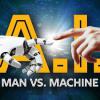
Breaking News
 This One-Person eVTOL Will Soon Offer Bird's-eye Views of Las Vegas
This One-Person eVTOL Will Soon Offer Bird's-eye Views of Las Vegas
 Emergency Update: Steve Slepcevic Reports Live on Hurricane Melissa's Devastation in Jamaica
Emergency Update: Steve Slepcevic Reports Live on Hurricane Melissa's Devastation in Jamaica
 What are they hiding? New evidence in Charlie Kirk's shooting shakes up the case | Redacted
What are they hiding? New evidence in Charlie Kirk's shooting shakes up the case | Redacted
Top Tech News
 Graphene Dream Becomes a Reality as Miracle Material Enters Production for Better Chips, Batteries
Graphene Dream Becomes a Reality as Miracle Material Enters Production for Better Chips, Batteries
 Virtual Fencing May Allow Thousands More Cattle to Be Ranched on Land Rather Than in Barns
Virtual Fencing May Allow Thousands More Cattle to Be Ranched on Land Rather Than in Barns
 Prominent Personalities Sign Letter Seeking Ban On 'Development Of Superintelligence'
Prominent Personalities Sign Letter Seeking Ban On 'Development Of Superintelligence'
 Why 'Mirror Life' Is Causing Some Genetic Scientists To Freak Out
Why 'Mirror Life' Is Causing Some Genetic Scientists To Freak Out
 Retina e-paper promises screens 'visually indistinguishable from reality'
Retina e-paper promises screens 'visually indistinguishable from reality'
 Scientists baffled as interstellar visitor appears to reverse thrust before vanishing behind the sun
Scientists baffled as interstellar visitor appears to reverse thrust before vanishing behind the sun
 Future of Satellite of Direct to Cellphone
Future of Satellite of Direct to Cellphone
 Amazon goes nuclear with new modular reactor plant
Amazon goes nuclear with new modular reactor plant
 China Is Making 800-Mile EV Batteries. Here's Why America Can't Have Them
China Is Making 800-Mile EV Batteries. Here's Why America Can't Have Them
Yale Researchers Develop mRNA-Based Lyme Disease Vaccine

Instead of triggering an immune response against a particular pathogen, the new vaccine prompts a quick response in the skin to components of tick saliva, limiting the amount of time that ticks have to feed upon and infect the host, the study shows.
The vaccine is delivered by the same mRNA technology that has proved so effective against COVID-19.
In the United States, at least 40,000 cases of Lyme disease are reported annually, but the actual numbers of infections could be 10 times greater, researchers said. In addition, other tick-borne diseases have also spread in many areas of the U.S.
"There are multiple tick-borne diseases, and this approach potentially offers more broad-based protection than a vaccine that targets a specific pathogen," said senior author Erol Fikrig, the Waldemar Von Zedtwitz Professor of Medicine (infectious Diseases) at Yale and professor of epidemiology (microbial diseases) and of microbial pathogenesis. "It could also be used in conjunction with more traditional, pathogen-based vaccines to increase their efficacy."
The saliva of the black-legged tick Ixodes scapularis, which transmits the Lyme disease pathogen Borrelia burgdorferi, contains many proteins. The investigators focused on 19 separate proteins.
In search for the basis of the vaccine, the Yale researchers, in collaboration with a team led by Drew Weissman at the University of Pennsylvania, analyzed bits of mRNA that produce all 19 of the saliva proteins. A similar strategy was used in vaccines that effectively combat the SARS-Cov-2 virus. And in a series of experiments, they tested the vaccine on guinea pigs, which can be infected with the Lyme disease agent and have also been used as a model to study tick resistance.

 Handicapped America
Handicapped America China Innovates: Transforming Sand into Paper
China Innovates: Transforming Sand into Paper

